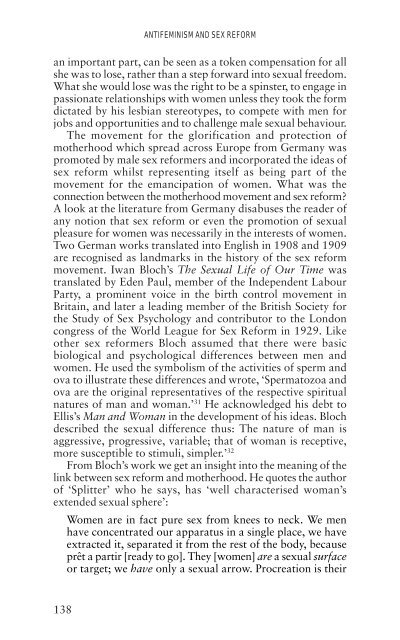The Spinster and Her Enemies - Feminish
The Spinster and Her Enemies - Feminish
The Spinster and Her Enemies - Feminish
You also want an ePaper? Increase the reach of your titles
YUMPU automatically turns print PDFs into web optimized ePapers that Google loves.
ANTIFEMINISM AND SEX REFORM<br />
an important part, can be seen as a token compensation for all<br />
she was to lose, rather than a step forward into sexual freedom.<br />
What she would lose was the right to be a spinster, to engage in<br />
passionate relationships with women unless they took the form<br />
dictated by his lesbian stereotypes, to compete with men for<br />
jobs <strong>and</strong> opportunities <strong>and</strong> to challenge male sexual behaviour.<br />
<strong>The</strong> movement for the glorification <strong>and</strong> protection of<br />
motherhood which spread across Europe from Germany was<br />
promoted by male sex reformers <strong>and</strong> incorporated the ideas of<br />
sex reform whilst representing itself as being part of the<br />
movement for the emancipation of women. What was the<br />
connection between the motherhood movement <strong>and</strong> sex reform?<br />
A look at the literature from Germany disabuses the reader of<br />
any notion that sex reform or even the promotion of sexual<br />
pleasure for women was necessarily in the interests of women.<br />
Two German works translated into English in 1908 <strong>and</strong> 1909<br />
are recognised as l<strong>and</strong>marks in the history of the sex reform<br />
movement. Iwan Bloch’s <strong>The</strong> Sexual Life of Our Time was<br />
translated by Eden Paul, member of the Independent Labour<br />
Party, a prominent voice in the birth control movement in<br />
Britain, <strong>and</strong> later a leading member of the British Society for<br />
the Study of Sex Psychology <strong>and</strong> contributor to the London<br />
congress of the World League for Sex Reform in 1929. Like<br />
other sex reformers Bloch assumed that there were basic<br />
biological <strong>and</strong> psychological differences between men <strong>and</strong><br />
women. He used the symbolism of the activities of sperm <strong>and</strong><br />
ova to illustrate these differences <strong>and</strong> wrote, ‘Spermatozoa <strong>and</strong><br />
ova are the original representatives of the respective spiritual<br />
natures of man <strong>and</strong> woman.’ 31 He acknowledged his debt to<br />
Ellis’s Man <strong>and</strong> Woman in the development of his ideas. Bloch<br />
described the sexual difference thus: <strong>The</strong> nature of man is<br />
aggressive, progressive, variable; that of woman is receptive,<br />
more susceptible to stimuli, simpler.’ 32<br />
From Bloch’s work we get an insight into the meaning of the<br />
link between sex reform <strong>and</strong> motherhood. He quotes the author<br />
of ‘Splitter’ who he says, has ‘well characterised woman’s<br />
extended sexual sphere’:<br />
Women are in fact pure sex from knees to neck. We men<br />
have concentrated our apparatus in a single place, we have<br />
extracted it, separated it from the rest of the body, because<br />
prêt a partir [ready to go]. <strong>The</strong>y [women] are a sexual surface<br />
or target; we have only a sexual arrow. Procreation is their<br />
138

















